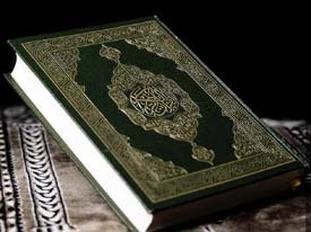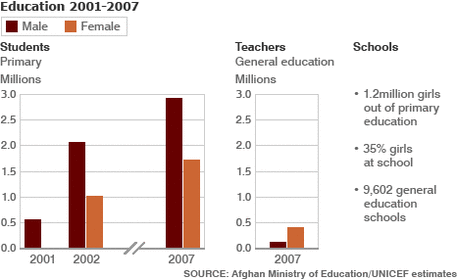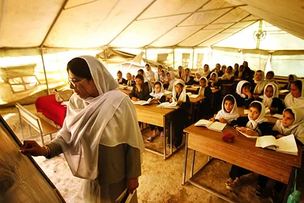Education in Afghanistan
Overview
Afghanistan has had one of the poorest education records that this world has seen. Under the Taliban, curriculum was restricted, schools were shut down and burned down, and women were banned from getting an education all together. Once they fell from power, a massive educational reform took place. More and more students enrolled, and literacy numbers increased. Although progress has been made, Afghanistan still has a long way to go before their education system is up to par with the rest of the world.
Afghanistan has had one of the poorest education records that this world has seen. Under the Taliban, curriculum was restricted, schools were shut down and burned down, and women were banned from getting an education all together. Once they fell from power, a massive educational reform took place. More and more students enrolled, and literacy numbers increased. Although progress has been made, Afghanistan still has a long way to go before their education system is up to par with the rest of the world.
Religion in Education

The Koran
When the Soviet Union Forces took over in 1979. They immediately forced religion into the curriculum at the expense of all other subjects(BBC).
In the ancient Islamic schools reading, writing and arithmetic were also often
included (Kamgar 1998, Rafi 1998). Moral education, such as the individuals' duties
and obligations towards him/herself, the family and the society was also an important part; sometimes also vocational training such as calligraphy and accounting was included (Mansory, 2000).
Today, some children attend madrasas (only for boys) where they receive
religious education and some children attend ordinary primary school, which also
have several hours per week of Islamic education. Practically all children, boys and
girls, attend a Koran or a Mosque School when they are in of pre-school age.
In the ancient Islamic schools reading, writing and arithmetic were also often
included (Kamgar 1998, Rafi 1998). Moral education, such as the individuals' duties
and obligations towards him/herself, the family and the society was also an important part; sometimes also vocational training such as calligraphy and accounting was included (Mansory, 2000).
Today, some children attend madrasas (only for boys) where they receive
religious education and some children attend ordinary primary school, which also
have several hours per week of Islamic education. Practically all children, boys and
girls, attend a Koran or a Mosque School when they are in of pre-school age.
Female Education

A chart depicting the increase in females being educated in Afghanistan since 2001.
Women and girls have never really had the same opportunities or rights to education as men and boys have had in Afghanistan. Between 1996 and 2001, females were banned from obtaining an education. The government closed all of the girls' schools in the country and prevented female teachers from working. Many parents feared that their daughters would grow up illiterate. Some girls were secretly educated in their homes by parents and teachers; others attended underground schools(BBC).
Schools for girls have come under increasing attack. According to Unicef, there were 16 improvised bomb attacks on school premises between January and June of 2009.
Schools for girls have come under increasing attack. According to Unicef, there were 16 improvised bomb attacks on school premises between January and June of 2009.
Progression of Education
Although education in Afghanistan has had a rough history, it has made steps towards improvement.
Since the defeat of the Taleban in 2001, at least 3,500 schools have been built and hundreds more are planned. More than six million students, about 30 percent girls, are enrolled in 11,000 schools across the country, compared to about one million boys in 2000, according to the Ministry of Education(www.schoolisopen.org). In total, more than a million girls are now at school in Afghanistan. More girls are now attending school in Afghanistan than in the decade before the Taleban introduced its ban on female education. Several hundred women have also taken the entrance exams required for admission to the University of Kabul. However, there is shortage of trained teachers at every level of education(BBC).
Since the defeat of the Taleban in 2001, at least 3,500 schools have been built and hundreds more are planned. More than six million students, about 30 percent girls, are enrolled in 11,000 schools across the country, compared to about one million boys in 2000, according to the Ministry of Education(www.schoolisopen.org). In total, more than a million girls are now at school in Afghanistan. More girls are now attending school in Afghanistan than in the decade before the Taleban introduced its ban on female education. Several hundred women have also taken the entrance exams required for admission to the University of Kabul. However, there is shortage of trained teachers at every level of education(BBC).
References
http://www.bbc.co.uk/worldservice/people/features/ihavearightto/four_b/casestudy_art26.shtml
http://news.bbc.co.uk/2/hi/uk_news/7741767.stm
http://www.afghanistans.com/information/people/education.htm
http://ddp-ext.worldbank.org/EdStats/AFGstu08.pdf
http://www.schoolisopen.org/sio/index.php?option=com_content&view=article&id=53&Itemid=62
http://www.bbc.co.uk/worldservice/people/features/ihavearightto/four_b/casestudy_art26.shtml
http://news.bbc.co.uk/2/hi/uk_news/7741767.stm
http://www.afghanistans.com/information/people/education.htm
http://ddp-ext.worldbank.org/EdStats/AFGstu08.pdf
http://www.schoolisopen.org/sio/index.php?option=com_content&view=article&id=53&Itemid=62

